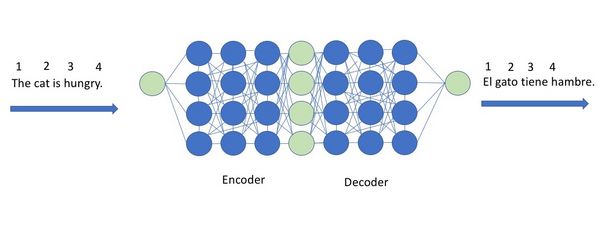Artificial Intelligence has allowed us to boost productivity in machine translation. So where to from here? Which way to go with regard to pre-editing and training with one’s own data? What we need is the expertise of technical communicators.
In Neural Machine Translation (NMT), a number vector is generated for each word in the input sentence (“input word”). During the machine translation process, an encoder enriches each input word with contextual information from the entire input sentence. A decoder generates the output words and builds the output sentence word by word. The probability of each following word results from the words of the input sentence and all previously generated output words (Figure 1).

Figure 1: Encoder decoder architecture
The success of this translation method is based on the use of artificial neural networks. In the brain, nerve cells (neurons) are connected to each other by synapses, thus creating “neural networks”.
Artificial neural networks (ANNs) are programs that learn what the expected outputs are for certain input values by linking data during training. This is how AI systems can ...
Read more after login
tekom members can log in directly with their "My tekom" access data.
You are not yet a tekom member, but would like to read one or more articles in full? Then you have the opportunity to register on the internet portal of the technical journal 'tcworld' without obligation. Once you have registered, you can select any three specialist articles and view them in full for a period of two months. The selection will then be deleted and you can select three new articles for the next two months.
As a tekom member you benefit from the following advantages::
- Online access to all articles of the trade magazine 'tcworld magazine'
- Exclusive specialist articles from all areas of technical communication
- Regular new articles from over 300 authors
- The technical journal 'tcworld magazine' as a printed edition
- Reduced admission prices to tekom conferences
- Membership fees for tekom publications
- Access to 'my tekom', the web forum with job offers / job requests, appointments, expert advice, service provider file and much more
Login
Registration
Promised: The trade magazine 'tcworld magazine' is the best we have. And we don't make the choice easy for ourselves. Every month, the editorial staff of the technical journal 'tcworld magazine' publishes the latest articles by renowned authors. This demanding selection is available exclusively to members of tekom (as usual, including the printed edition).
The trade magazine 'tcworld magazine' stands for intelligently prepared specialist articles, texts written to the point, informative content, surprising insights, international perspectives and communicates technical communication in an understandable, fast, clear and uncomplicated way - exclusively for you.


